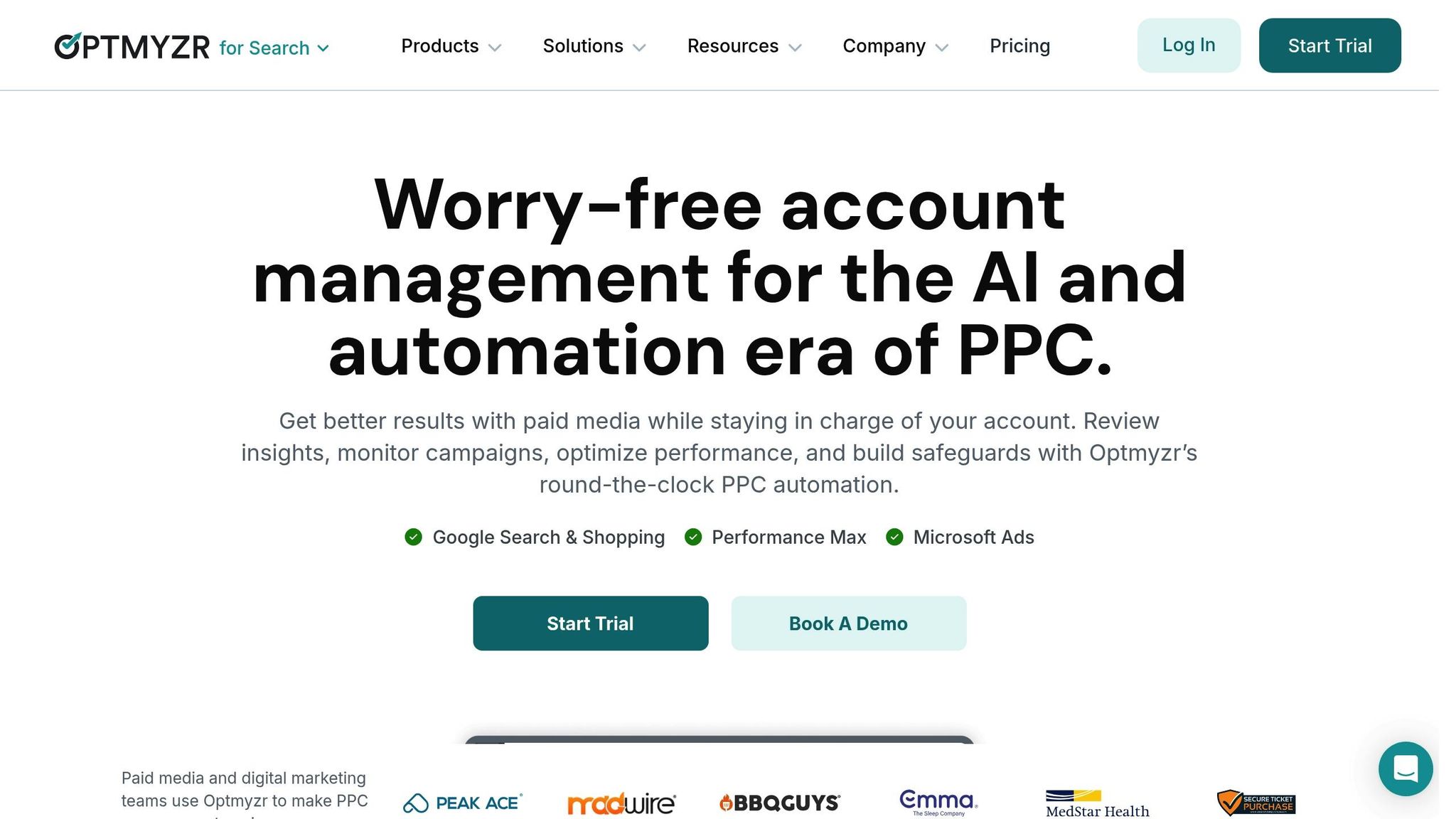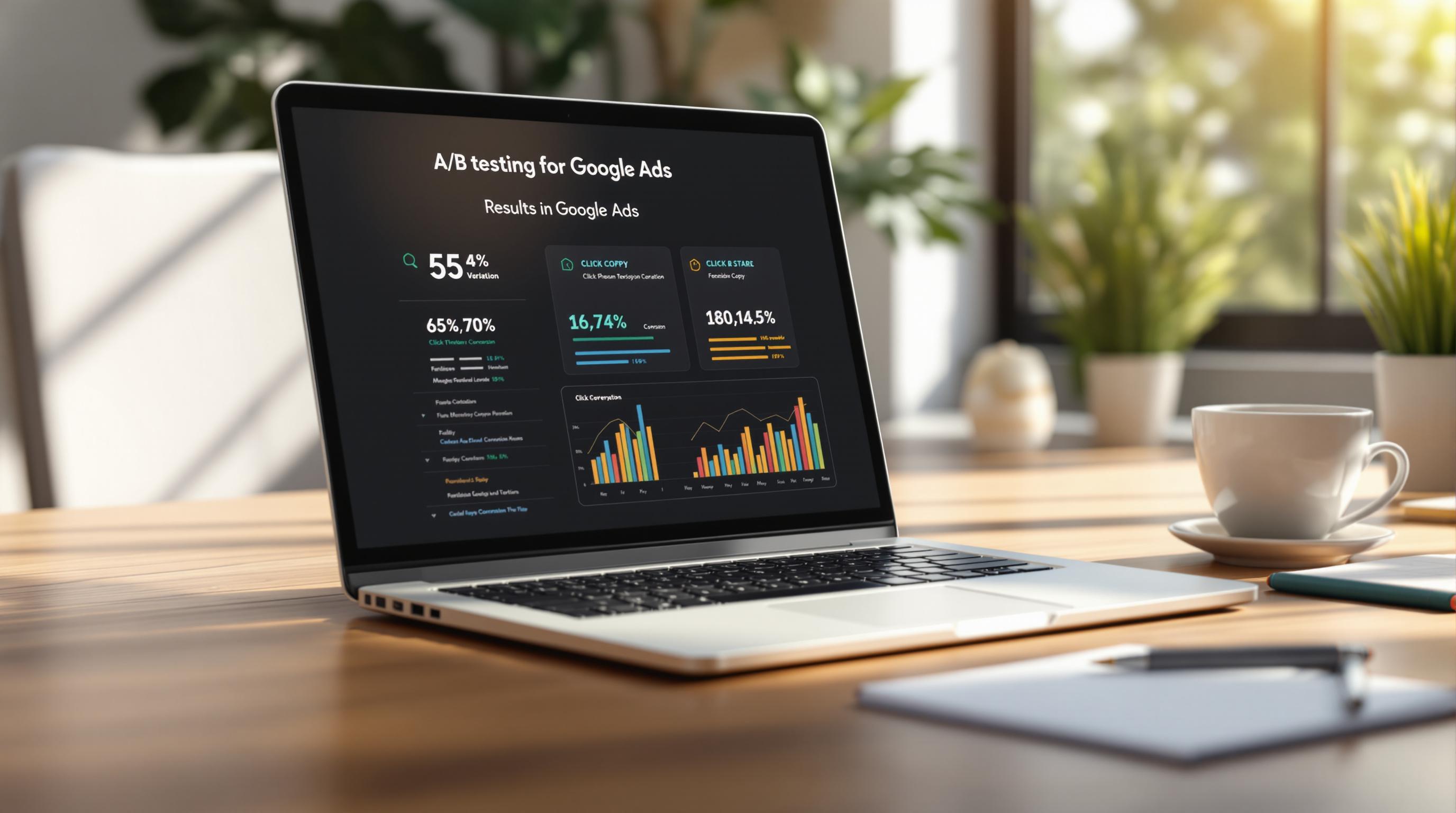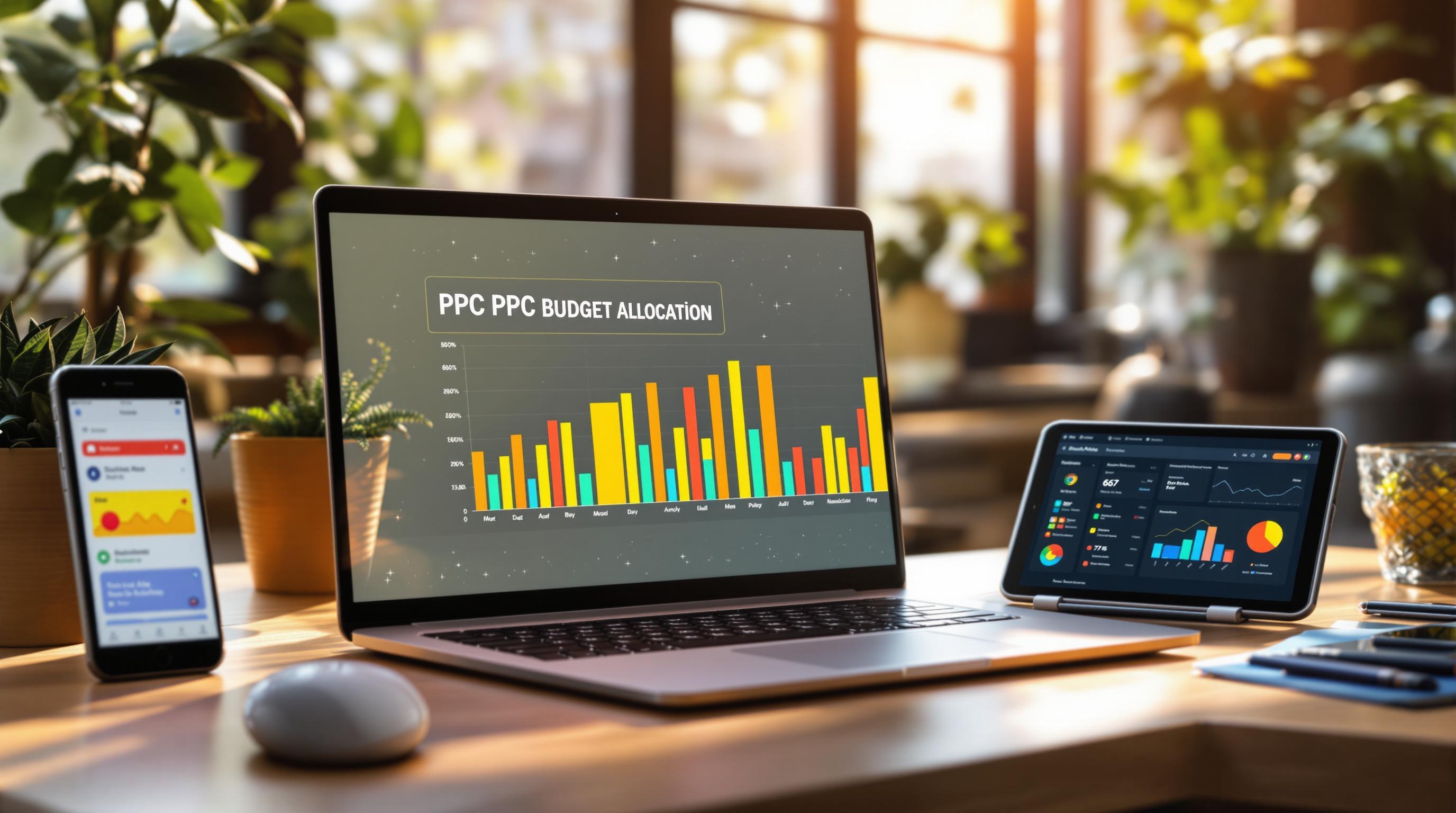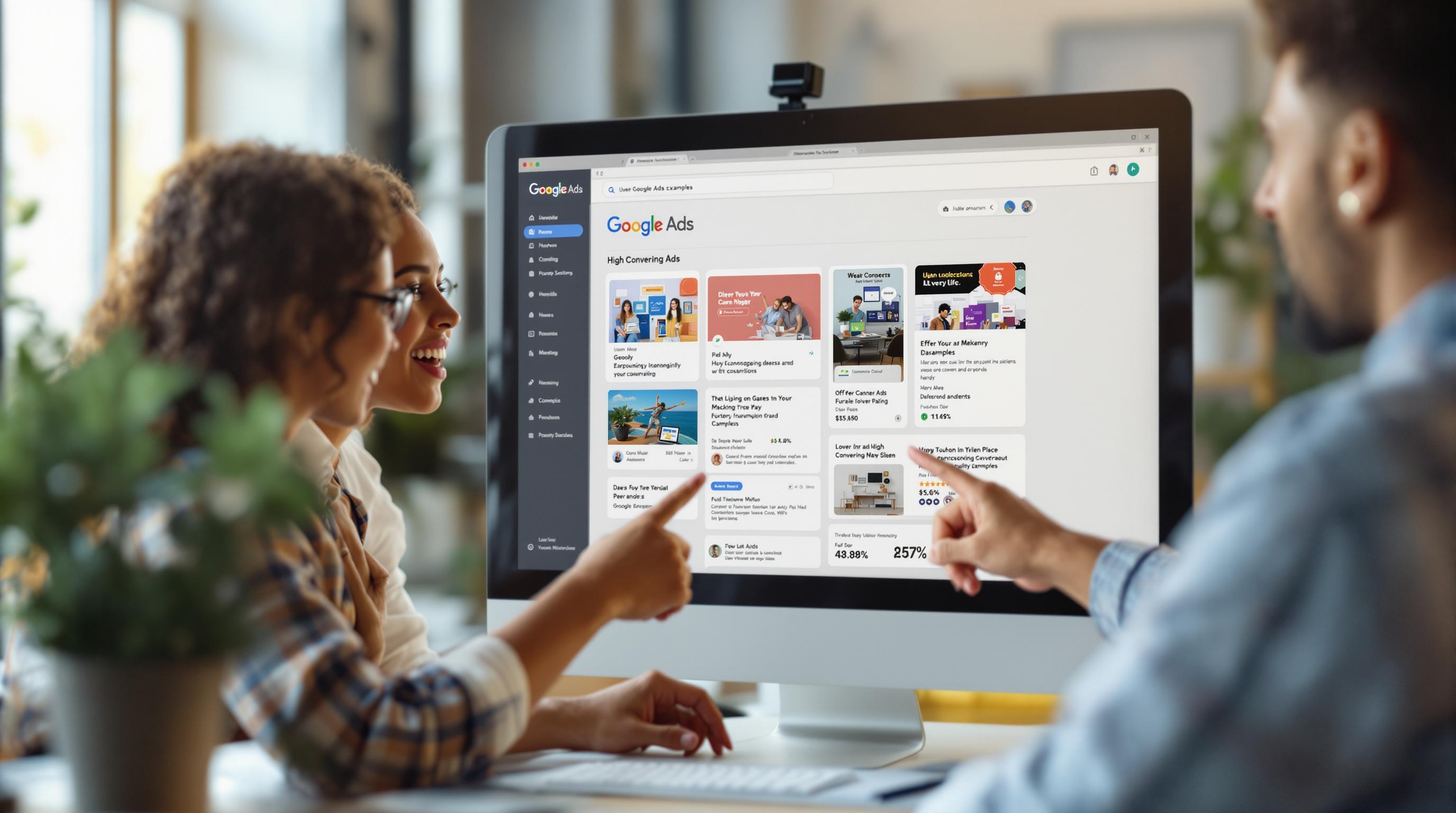Cross-platform budget optimization is about managing ad spend across platforms like Google Ads, Meta Ads, and Amazon Ads to maximize ROI. Instead of treating each platform separately, it focuses on aligning them to achieve your overall marketing goals. Here's what you need to know:
- Why It Matters: US campaigns face unique challenges like regional differences, high competition, and diverse consumer behavior. Weekly reviews and real-time adjustments can improve ROI and reduce wasted spend.
- Key Steps:
- Set clear goals using the SMART framework (e.g., "Increase Q1 sales by 20% while keeping CPA at $50").
- Match goals with platform-specific KPIs (e.g., ROAS for Google Ads, CTR for Meta Ads, CPL for LinkedIn).
- Use historical data to allocate budgets effectively.
- Keep 40-60% of your budget for proven strategies, 10-20% for testing, and adjust weekly.
- Tools and Automation: Unified reporting and automation tools (e.g., SuperMetrics, Adverity) simplify tracking and decision-making.
- Monitoring: Weekly KPI reviews and side-by-side comparisons help identify where to shift budgets for better performance.
Setting Clear Goals and Performance Metrics
Defining Campaign Goals
Clear and measurable goals are the backbone of effective cross-platform budget planning. Without well-defined objectives, budget allocation becomes a guessing game. Many successful campaigns in the US rely on the SMART framework: Specific, Measurable, Achievable, Relevant, and Time-bound.
For instance, instead of vaguely aiming to "increase sales", a SMART goal would look like this: "Increase online sales by 20% in Q1 2026 while maintaining a target CPA of $50." This level of specificity allows for smarter decisions about where and how to spend your advertising dollars.
Campaign goals often center around brand awareness, sales growth, or lead generation. Each of these requires a tailored approach to budget allocation. Let’s say a US-based e-commerce retailer wants to boost Q4 sales by 25%. In this case, you might allocate 60% of the budget to Google Shopping and Search for their high purchase intent, 25% to Meta platforms for retargeting and prospecting, and the remaining 15% to experimenting with new platforms.
A good rule of thumb is to dedicate 40–60% of your budget to proven strategies while keeping 10–20% for testing new approaches. Once your goals are crystal clear, the next step is to align them with platform-specific performance metrics.
Setting Platform-Specific KPIs
After defining your campaign goals, the key to maximizing efficiency lies in matching each goal with the right KPIs for each platform. Every PPC platform has its own strengths, which means measurement strategies should adapt accordingly. While an overarching strategy is essential, the specific metrics you track must reflect user behavior and the platform’s unique environment.
For Google Ads, the focus is often on Cost Per Acquisition (CPA) and Return on Ad Spend (ROAS), especially for direct response campaigns. Industry data shows that for e-commerce, the average CPA on Google ranges from $40 to $60, with ROAS targets typically set at 400% or more. The high-intent nature of Google search traffic makes these metrics especially relevant.
On Meta platforms (Facebook and Instagram), a broader range of metrics is necessary. While Click-Through Rate (CTR) and CPA remain important, engagement metrics like likes, shares, and comments also play a significant role. Meta tends to have lower CTRs compared to search platforms but often delivers higher engagement rates, making it crucial to track both awareness and conversion metrics.
For LinkedIn, which is particularly effective for B2B campaigns, Cost Per Lead (CPL) is the go-to metric. LinkedIn excels at reaching decision-makers, but its longer sales cycles make immediate ROAS less relevant. Instead, CPL and lead quality are better indicators of success.
| Platform | Primary KPIs | Secondary KPIs | Typical US Benchmarks |
|---|---|---|---|
| Google Ads | CPA, ROAS | CTR, Quality Score | CPA $40–$60, ROAS 400%+ |
| Meta Ads | CTR, CPA | Engagement Rate | Lower CTR, Higher Engagement |
| CPL, CTR | Engagement Rate, Lead Quality | Higher CPL, Longer Sales Cycle |
Regularly reviewing these KPIs ensures that each platform plays its part in achieving your overall goals. Unified reporting is essential when managing multiple platforms, as it provides a complete picture of how each contributes to the bigger picture. By analyzing performance data side by side, you can make more informed decisions about budget allocation.
To stay competitive in the fast-paced US market, frequent KPI reviews are non-negotiable. Weekly reviews help you catch immediate issues, monthly trend analyses provide deeper insights, and quarterly adjustments keep you aligned with shifts in algorithms or market conditions. For example, strategies that worked in Q3 might not hold up during high-stakes periods like Black Friday or back-to-school shopping seasons.
If tracking KPIs and setting goals feels overwhelming, the Top PPC Marketing Directory offers vetted agencies and tools that specialize in campaign management, bid strategies, and performance tracking. These resources can simplify the process, helping you identify the right metrics for your business and streamline cross-platform optimization.
Learn With Optmyzr: Smarter Portfolio Budgeting with Optmyzr

Data-Driven Budget Allocation Methods
Allocating budgets effectively means relying on data, not just intuition or splitting funds evenly across platforms. The most effective US PPC campaigns focus on performance metrics to make sure every dollar counts. This strategy builds on analyzing past trends and adjusting based on what works best.
Using Historical ROI and Performance Data
Looking at past campaign performance can offer valuable insights into future success. For instance, if Google Ads consistently deliver a 5:1 ROAS (Return on Ad Spend) while Facebook Ads only achieve 3:1, it makes sense to allocate more budget to Google Ads. Historical data also highlights seasonal patterns and audience behaviors. A US retailer, for example, might notice that Google Shopping campaigns perform exceptionally well during the fourth quarter, whereas social media campaigns tend to shine in the summer.
To make informed decisions, establish a baseline for each platform by tracking key metrics like cost per acquisition (CPA), conversion rates, and customer lifetime value. Regularly reviewing this data is crucial because performance can shift, requiring quick adjustments to your budget.
Splitting Budgets for High ROI and Testing
A balanced approach to budget allocation involves dedicating 40%-60% of your budget to proven, revenue-generating campaigns while reserving 15%-20% for testing new ideas. This ensures you maintain a strong foundation while staying open to innovation and emerging trends.
For example, you might allocate 55% of your budget to high-performing channels and 20% to test new platforms or strategies. Testing budgets should come with clear goals, such as achieving a specific CPA, generating a set number of qualified leads, or hitting a target ROAS within a defined timeframe.
To streamline this process, consider grouping campaigns into tiers based on past performance. Tier 1 campaigns, which yield the best results, get the largest share of the budget and the most attention. Tier 2 campaigns receive moderate funding and regular optimization, while Tier 3 is reserved for experimental efforts with clear criteria for scaling up. Automated tools can further help by adjusting these allocations dynamically based on real-time performance.
Using Geographic and Demographic Data
The US market is diverse, and a one-size-fits-all budget strategy won’t cut it. Geographic data can reveal that certain regions, like Los Angeles or New York City, consistently outperform smaller markets. By analyzing conversion rates and acquisition costs by region, you can reallocate spending to maximize returns.
Demographic insights add another layer of precision. Different age groups, income levels, and interests influence how audiences engage with your ads. For instance, your social media campaigns might resonate more with younger audiences, while other platforms may be better suited for reaching professionals or decision-makers.
Seasonal and regional factors also play a role. For example, a retailer specializing in winter sports equipment might allocate more budget to campaigns targeting mountain states during ski season, while scaling back in warmer areas. Similarly, local events or weather patterns can create short-term opportunities for budget adjustments.
To refine these strategies, tools and expert agencies listed in the Top PPC Marketing Directory can help you dive deeper into geographic and demographic data. These resources enable dynamic budget adjustments based on real-time insights, such as increasing investment in high-converting zip codes or reallocating funds to target promising audience segments. By continuously monitoring performance, you can ensure your ad spend is always directed where it yields the best results.
Using Automation and Tools for Optimization
Managing budgets across multiple platforms manually can feel like an uphill battle, especially when you're dealing with constant shifts in real-time data. To truly optimize budgets across platforms, automation and the right tools are essential. Let’s break down why automation is a game-changer.
Benefits of Automation in Budget Optimization
Automation takes the guesswork out of managing budgets across platforms by handling real-time data and enabling faster, more informed decisions. Instead of spending hours crunching numbers and gathering reports, automated systems handle these tasks instantly, allowing teams to focus on strategy. For instance, Vincent V., Founder of Iguality, shared how his team:
dramatically improved our reporting speed by about 60%
after adopting automated reporting solutions. This time saved translates into quicker responses to performance changes and better allocation of resources. Many top brands have experienced similar gains, using automation to not only speed up reporting but also enhance overall performance. Once you’ve embraced automation, the next step is selecting the right tools to strengthen your approach.
Cross-Platform Budget Management Tools
The tools you choose can make or break your cross-platform campaigns. Look for tools that integrate marketing, sales, and finance data while leveraging AI-driven insights to minimize errors and save time. Specialized options like SuperMetrics, which consolidates data, and Adverity, which connects to over 500 data sources, can centralize your information and simplify decision-making. The best tools also integrate seamlessly with platforms like Google Ads, Microsoft Ads, and Facebook Ads, ensuring a smooth workflow. With these solutions in place, you’re ready to take advantage of unified reporting to drive smarter decisions.
Unified Reporting for Better Decision-Making
When campaign data is scattered across various platforms, it’s easy to miss critical trends. Unified reporting solves this issue by bringing all your campaign metrics into one dashboard, creating a single source of truth for decision-making. For example, a unified dashboard might reveal that Google Ads performs better on weekdays, while social media campaigns thrive on weekends, enabling you to fine-tune your budget accordingly. Terminal 1 demonstrated this by automating their reporting at scale, simplifying the management of numerous campaigns and clients.
Additionally, AI-powered reporting tools can highlight important trends and suggest actionable improvements, keeping sales and marketing teams aligned on priorities. Unified reporting doesn’t just organize your data - it strengthens your overall cross-platform strategy. Tools listed in the Top PPC Marketing Directory offer the advanced analytics and infrastructure you need to implement these systems effectively.
sbb-itb-89b8f36
Monitoring and Optimizing Performance
Once you've allocated your budget based on data, the next step is keeping a close eye on performance. Success here hinges on consistent monitoring and making adjustments as needed. This isn't about glancing at reports once a month - it's about having a system in place for regular tracking, analysis, and fine-tuning.
Setting Up Tracking Systems
A reliable tracking system is the backbone of managing campaigns across multiple platforms. To get started, you need three key components: conversion tracking, analytics integration, and data consolidation across all platforms.
Begin by using Google Tag Manager to implement tracking codes. This tool simplifies the process, especially if you're managing campaigns on several platforms. Then, integrate Google Analytics to gain insights into user behavior and conversion paths. Make sure your tracking aligns with campaign goals. For example, if you're prioritizing sales, enable e-commerce tracking. If you're focused on generating leads, set up goal completions instead.
To streamline data analysis, tools like Coupler.io can pull metrics from platforms such as Google Ads, Facebook, and Microsoft Ads into a single dashboard. This ensures you can compare performance easily. Keep in mind that campaigns often falter due to incomplete conversion tracking or inconsistent pixel setups. Make sure every platform is tracking the same conversion events and using consistent naming conventions.
These tracking systems will serve as the foundation for your performance reviews.
Creating Review Cycles
Regular reviews are essential to catch performance trends early. Weekly reviews strike a good balance - they're frequent enough to identify shifts without getting bogged down by daily fluctuations. As PPC expert Mark Irvine puts it:
A comical number of problems in PPC are solved with basic math and simple budget management. That's not even an SMB problem – 'just move money around' is a 10-minute solution that can fix accounts of any size.
During these reviews, focus on metrics like cost per acquisition (CPA), return on ad spend (ROAS), click-through rates (CTR), and conversion rates. Compare these numbers to the previous week to spot trends. For example, if one campaign consistently beats its CPA target while another struggles, consider reallocating budget in real time to maximize results.
If weekly reviews feel too frequent, bi-weekly reviews can work, but avoid stretching them to monthly intervals. Market conditions and competitor actions can shift quickly, and monthly reviews may leave you reacting too late.
Side-by-Side Platform Comparisons
After setting up review cycles, comparing metrics across platforms helps identify where to shift your budget. Consolidate key data into a comparison table like the one below:
| Platform | CPC | CTR | Conv. Rate | ROAS | Weekly Spend |
|---|---|---|---|---|---|
| Google Ads | $2.45 | 3.2% | 4.1% | 4.2x | $2,800 |
| Facebook Ads | $1.85 | 2.8% | 3.7% | 3.8x | $1,900 |
| Microsoft Ads | $1.92 | 3.5% | 4.3% | 4.5x | $1,200 |
| LinkedIn Ads | $4.20 | 1.9% | 2.8% | 2.9x | $800 |
For example, in this table, Microsoft Ads delivers the highest ROAS despite lower spend, signaling a potential opportunity to increase its budget. Meanwhile, LinkedIn Ads underperform across most metrics, suggesting the need for adjustments or reduced spending.
Adding demographic and geographic insights can further refine your strategy. If your 25–34 age group delivers 40% higher conversion rates on Facebook but struggles on LinkedIn, adjust your targeting and budget accordingly.
To make smarter decisions, focus on trends over several weeks - ideally 4–6 weeks - rather than single-week snapshots. This helps you identify consistent performers and avoid overreacting to short-term fluctuations.
Tools like WhatConverts can simplify these comparisons by generating detailed reports that spotlight top-performing campaigns. Similarly, Coupler.io consolidates multichannel data into easy-to-read dashboards.
Finally, remember that platforms like Google Search often bring in high-intent traffic, which may justify higher CPCs. On the other hand, platforms like Facebook retargeting can work well for cost-effective audience engagement. The goal isn't just to lower costs - it’s to focus on platforms that deliver the best overall return based on your business objectives.
Using Directory Resources for PPC Optimization
With automation and unified reporting simplifying budget management, directories provide a valuable resource for streamlining PPC campaign implementation. By combining data-driven allocation with curated tools and expert services, these directories make campaign management more efficient.
How Directories Support Cross-Platform Campaigns
Running PPC campaigns across multiple platforms can be a challenge. Different interfaces, inconsistent metrics, and an overwhelming number of tools often complicate budget allocation and decision-making. This complexity can lead to missed opportunities and underperforming campaigns.
Curated directories address these challenges by consolidating trusted resources in one place. Instead of spending hours researching vendors, you can quickly find tools for tasks like campaign management, bid optimization, keyword research, ad copy refinement, A/B testing, retargeting, and performance tracking. This streamlined approach not only saves time but also minimizes the risk of choosing the wrong tools.
Unlike platforms that present every available option, quality directories carefully vet their listings to ensure only the best resources are included. This allows marketers to shift their focus from exhaustive research to strategic execution. It’s a crucial advantage, especially when 75% of users report that paid ads help them find what they’re looking for more easily. To achieve these results, having access to the right tools and expertise is essential - precisely what curated directories deliver.
Features of the Top PPC Marketing Directory
The Top PPC Marketing Directory is tailored to meet the needs of US marketers managing complex, multi-platform campaigns. By offering a curated selection of PPC tools, agencies, and services, it simplifies the process of finding the right solutions for every stage of campaign management.
The directory organizes resources into categories, covering areas like campaign management, bid strategy, and performance tracking. For example, its performance tracking tools provide the unified reporting capabilities needed to make informed, data-driven budget decisions.
What sets top-quality directories apart is their rigorous vetting process. This ensures that marketers save time and reduce the risk of poor tool selection - an especially important benefit given that 75% of users value paid ads for their ability to simplify searches.
For US-based marketers, the directory offers additional advantages. It includes tools and agencies that are familiar with dollar-based budget tracking, US date formats (MM/DD/YYYY), and other local market nuances. This ensures better alignment with campaign needs and avoids compatibility issues.
The platform also provides comparative information, allowing marketers to evaluate tools side-by-side based on features, pricing in USD, and specific use cases. This is particularly helpful when testing strategies, as it enables quick identification of tools that can generate actionable data within the typical 2–4 week testing period.
| Feature | Benefit for Cross-Platform Optimization |
|---|---|
| Curated Listings | Save time and reduce the risk of poor tool selection |
| Category Organization | Easy access to tools for campaign management, bidding, and tracking |
| Expert Reviews | User ratings guide you to the best-fit solutions |
| Local US Market Focus | Tools tailored for dollar tracking and local requirements ensure smooth implementation |
In addition to tools, the directory includes agency listings that support the launch, scaling, and targeting of cross-platform campaigns.
This directory aligns with the growing preference for centralized PPC management via unified dashboards. By offering organized access to advanced tools, it simplifies the process of monitoring, comparing, and optimizing campaigns across platforms. This centralized approach not only saves time but also supports a cohesive strategy to refine cross-platform PPC performance and make budget diversification more effective.
Conclusion and Key Takeaways
Summary of Best Practices
Optimizing a cross-platform budget is not a one-and-done task - it’s an ongoing effort that balances short-term results with long-term growth. The most effective marketers stick to a clear framework that emphasizes strategic planning and continuous fine-tuning.
Start with a smart budget allocation. Dedicate 40-60% of your budget to platforms with a proven track record of delivering high ROI. Keep 20-30% for testing new strategies and set aside 10-20% for niche platforms that could offer untapped opportunities.
Testing isn’t optional - it’s essential. Reserve 10-20% of your PPC budget specifically for testing. This allows you to try out new platforms, ad formats, and audience segments without disrupting your primary campaigns.
Review performance weekly. Regularly scheduled performance assessments and budget tweaks ensure your campaigns stay aligned with evolving market trends.
Think in terms of the funnel. Allocate the majority of your budget to bottom-of-funnel keywords that drive conversions and invest in branded keywords for efficiency. Use a smaller portion for top-of-funnel keywords to build brand awareness.
Leverage insights across channels. Share learnings from high-performing platforms to enhance your overall PPC strategy and avoid working in silos.
These practices form the backbone of a flexible and effective cross-platform budget strategy.
Final Thoughts on Budget Optimization
As digital advertising evolves, staying ahead means embracing the right tools and strategies. Research by Nielsen shows that consumers exposed to ads across multiple platforms are 250% more engaged compared to those who see ads on just one channel. This highlights the importance of cross-platform optimization for maximizing ROI.
Automation and streamlined reporting tools are critical for managing complex campaigns. They help identify growth opportunities, avoid performance dips, and make quick adjustments. Tools like those listed in the Top PPC Marketing Directory are excellent resources for finding expert agencies and software tailored to dollar-based budgets and U.S. market needs.
Here’s another key insight: 75% of users say paid ads make it easier to find what they’re looking for. To meet this expectation, you need to maintain high performance standards through constant monitoring and refinement - exactly what these best practices support when implemented consistently.
Long-term success in cross-platform PPC lies in treating it as a dynamic process. By setting up robust tracking systems, staying flexible with your budget, and using the right tools, you can achieve steady campaign growth and better ROI across all your advertising platforms.
FAQs
What’s the best way to distribute my budget across multiple ad platforms to maximize ROI?
To get the most out of your advertising budget across multiple platforms, it’s essential to start with a detailed performance analysis. Pay close attention to metrics like cost-per-click (CPC), conversion rates, and customer acquisition costs. These numbers will help you pinpoint which platforms give you the best bang for your buck.
Once you’ve identified top-performing platforms, adjust your budget accordingly. Stay flexible and adapt based on performance trends and your campaign goals. Using tools that offer features like bid adjustments, keyword analysis, and A/B testing can streamline this process. These tools enable you to make smarter, data-backed decisions while boosting efficiency.
If you're looking to sharpen your strategy even further, consider exploring platforms that focus on PPC tools and services. They can offer valuable insights and resources to help you refine your approach and drive better results.
What key performance indicators (KPIs) should I track for platforms like Google Ads, Meta Ads, and LinkedIn?
To make the most of your PPC budgets on platforms like Google Ads, Meta Ads, and LinkedIn, it's crucial to focus on metrics that match your campaign objectives.
For Google Ads, keep an eye on these key metrics: click-through rate (CTR), cost per click (CPC), conversion rate, and quality score. These numbers help gauge how effectively your ads are performing and whether they're driving meaningful interactions.
On Meta Ads, metrics like engagement rate, cost per result, and return on ad spend (ROAS) take center stage. These indicators are particularly useful for campaigns aimed at building awareness or driving social interaction.
For LinkedIn, focus on click-through rate, lead generation cost, and impression share. Since LinkedIn often caters to professional audiences, these metrics can help measure the success of campaigns targeting business leads or industry-specific audiences.
Each platform has unique strengths, so it's important to align your KPIs with your campaign goals. For instance, a brand awareness campaign on Meta Ads should prioritize engagement and reach, while a lead generation effort on LinkedIn would benefit from focusing on metrics like cost per lead and conversion rates. Tailoring your approach ensures you're getting the best results for your investment.
How do automation and unified reporting tools improve cross-platform budget optimization?
Automation and unified reporting tools make managing cross-platform budgets much easier by simplifying complicated tasks and offering a single, clear view of performance metrics. These tools analyze data from multiple PPC platforms in real time, helping you allocate your budget to the channels delivering the best results.
Automation takes care of repetitive tasks like adjusting bids, shifting budgets, and monitoring campaigns. This not only saves time but also minimizes the risk of human error. Meanwhile, unified reporting tools pull data from various platforms into one dashboard. This consolidated view helps you spot trends, address inefficiencies, and make smarter decisions to get the most out of your ROI.


